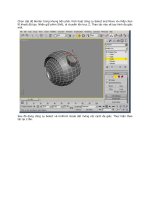Embedded Systems phần 2 pdf
Bạn đang xem bản rút gọn của tài liệu. Xem và tải ngay bản đầy đủ của tài liệu tại đây (360.48 KB, 11 trang )
11
Network Systems Architecture
Interfaces
General-purpose computer
(or handheld computer)
Bulk of I/O is between computer and human
Embedded System
Bulk of I/O is between system and other
devices or computers
How does this distinction affect the
complexity of I/O requirements?
12
Network Systems Architecture
Strict Specifications
I/O in General-Purpose Computer
What happens if the screen flickers a bit?
What happen if Microsoft Word draws a toolbar button
1 pixel to the right?
I/O in Embedded Systems
What happens if the welding robot is off by
1 inch?
What happens if the packet has 1 byte corrupted?
Close enough is not good enough
13
Network Systems Architecture
Real-Time System
Some I/O devices need to be controlled in real-time
Correctness depends on
Output being logically correct
Output occurring at correct time
Both are required!
Car processor must read sensors and decide whether to
deploy airbags in 15-30 milliseconds
Bad time to be running garbage collection algorithm over the
memory!
Similar story for traction control, ABS, etc…
Close enough is not good enough
14
Network Systems Architecture
Embedded Processors
Given the requirements of embedded systems,
how do we build them?
Select appropriate processor
Wide performance range
8-bit controller - Atmel ATMEGA168-20AU
20Mhz RISC, 16kB flash, no external memory, $4.00 at
DigiKey
32-bit processor, single core – NS486SX
Clone of Intel 486SX, 25MHz CISC, 32-bit external
memory addressing, $48 at DigiKey
Network processor – Cisco QuantumFlow
50 multi-threaded cores, 1.2 GHz, $$$
Azul Compute Appliance
Up to 768 cores / 768GB memory
Only runs Java applications
Optimized for power / cooling / space efficiency
15
Network Systems Architecture
Programming
What differences must a designer take into
account when programming these chips?
Intel Core2 Duo (64-bits)
Atmel ATMEGA (8-bits)
16
Network Systems Architecture
Programming Differences
Resources (CPU/Memory)
GP: Resources exceed single-app requirements
ES: Resources constrained to just meet requirements
(Does not mean memory is small or CPU slow)
Language
GP: C++, Perl, Python, Java, .NET, etc…
ES: Traditionally C (code size is important!)
OS / Libraries
GP: Full OS (Linux, Windows, OSX, …)
ES: No OS or embedded/real-time OS
(VxWorks, QNX, Windows CE, Linux variants)
17
Network Systems Architecture
Programming Differences
Time
GP: Most applications have loose time requirements
ES: Strict time requirements
What methods can a programmer use to satisfy
strict timing requirements?
Time slicing
Bound each task to take a predictable amount of time
Allow pre-emption for high-priority tasks
18
Network Systems Architecture
Real-Time OS
Provides requested service in a bounded
amount of time
Hard-Time
Guaranteed worst-case specifications
Will never take longer than X
Soft-Time
“Best-effort”
Will usually take no longer than X
What are some examples of both types of
systems?
19
Network Systems Architecture
VxWorks
Embedded / Real-Time OS
Multitasking Kernel (pre-emptive / multiprocessor)
Threads with priority-based scheduling and inheritance
Predictable thread synchronization
File system
Ported to most common embedded processors
MIPS, PowerPC, ARM, …
Noteworthy applications
Mars Rovers (Spirit and Opportunity)
Boeing 787 airliner
James Webb Space Telescope
BMW iDrive system
20
Network Systems Architecture
VxWorks
Why don’t these customers just use an
embedded version of Linux?
Technical advantages?
Stability for safety-critical applications
Optimized for code size / performance
Money to burn?
Tradition? (Nobody ever got fired for buying
IBM)
Experienced developers?
21
Network Systems Architecture
Processor Capabilities
Embedded systems use processors
tailored to domain-specific computation
requirements
Processor runs raw application and a real-
time OS if necessary
Is a processor + OS + application enough
to build the full spectrum of embedded
devices?









